Kate Rauner's Blog, page 100
March 5, 2014
Life in Rural America
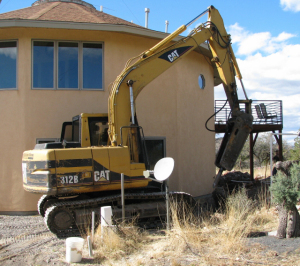
It takes a big excavator to trench through our limestone rock; I hold my breath when it’s close to the house.
I usually post a poem on Wednesdays, but I’ve been distracted this week by our project to run a water line from our newly-drilled well to the house. For ten years my husband and I have lived on top of a limestone ridge and had to haul our water to the house using a tank in the bed of our pickup truck. We are quite water-thrifty, and will continue to be thrifty even now that we have a well.
This is definitely a strange thought for most Americans, and it gets stranger. In addition to hauling our own water, we have our own septic system. That by itself isn’t rare, but because the limestone is nearly impermeable, our septic system is a “wetland”, where nitrogen is removed by cattails and sedges, and the waste water evaporates from a gravel “pond”. We also haul our own trash to a waste transfer station and drive a half hour to reach our grocery store. On the way home, once we turn off the highway, we’re on a bumpy mile-long dirt driveway we maintain ourselves with the help of our one neighbor. I’ve hauled a lot of loads of clay and rocks in my pickup, and battled pot holes and erosion with pickax and shovel. It can get quite treacherous in icy or muddy conditions and there have been times the car can’t make it all the way to the house.
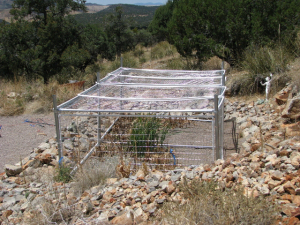
One year the deer and rabbits ate my septic system wetland down to nothing, andwe had to put up a fence.
Why would anyone want to live this way? Nothing we do seems strange to our neighbors; this is how many people live in rural southwest New Mexico. The area is poor compared to the rest of America. People do things themselves and there are a lot of do-it-yourself houses, sheds, gardens, and yard art. We’ve chosen this life, but some people are stuck here by poverty, lack of education, and sometimes by their own low expectations.
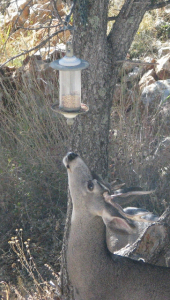
Deer try to raid my bird feeder
Rural America has been losing population steadily, and there are good reasons for that. The cities and suburbs have much to offer. I lived on Colorado’s Front Range for twenty-two years where I had museums, theaters, a nice zoo, loads of shopping and (especially) a good job. I’m glad I lived there and now I’m glad to live here.
To be happy in a rural home I think you need to be able to amuse yourself. Of course we have TV and Internet, books and magazines, and I enjoy my “town days” with visits to coffee houses, art galleries, and funky little shops. But I often go all week without seeing another person, and that’s okay. What I do see everyday is the Gila National Forest, right out my door.
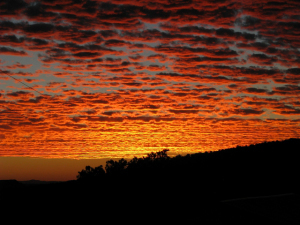
Sunset
March 1, 2014
Wild American Towns
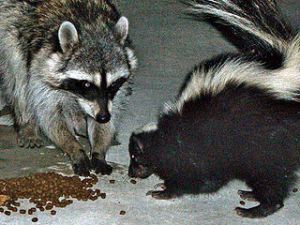
Wildlife likes cat food
Recently, I read an article about wildlife in cities. We may expect cities to displace birds, animals, and plants, but “two-thirds of the native plant and bird species continue to exist in cities” and some species are evolving to thrive in urban areas. Large parks and intentional attempts to provide habitat would improve the situation for wildlife.
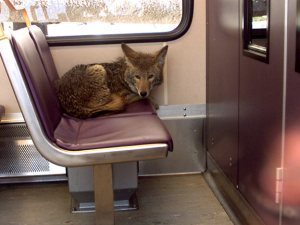
Coyote on train, Portland Oregon, Dennis Maxwell AP
Not all urban species may be welcomed with open arms. That old trickster, the coyote, adapts well to suburbs and cities, as do skunks and raccoons. All these critters can be dangerous, especially if you expect them to act like characters in a Disney movie. But if you treat them with respect and plan for your own safety as well as theirs, cities can be refuges. I live on the border of the Gila National Forest and living with wildlife is, on balance, a good thing.
“The overall picture is not bleak. Cities can provide new habitats that may be quite different from those in natural ecosystems but can still support a variety of species.”
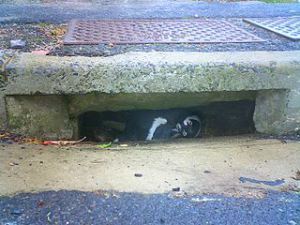
Look closely – that’s a penguin nest in a storm drain in Cape Town
February 26, 2014
Supernova – a poem by Kate Rauner

M82 in a composite picture
Once upon a time
In a galaxy far away,
A star exploded.
Went supernova.
Killed everything
That might have been
Nearby in its way.
Twelve million years later
With clouds closing in.
In place of lessons planned for
Scholars played with astral cameras,
Observing the pretty star machine,
Messier 82.
The light arrived
At the students’ eyes,
A star that shouldn’t be there.
Yet safe we fare,
For our Earthly sake
The light will just illuminate.
Better than a beer bash night
Is capturing a nova’s light.
London undergrads converse
On expansion of the universe.
“The discovery was a fluke – a 10 minute telescope workshop for undergraduate students that led to a global scramble to acquire confirming images and spectra of a supernova in one of the most unusual and interesting of our near-neighbour galaxies.” www.ucl.ac.uk








February 22, 2014
Earliest Human Footprints Outside Africa
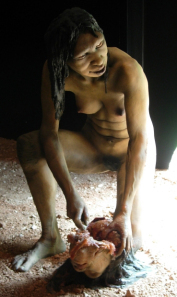
Model of Homo antecessor; Ibeas Museum, Burgos, Spain
This is a very cool find: human footprints more than 800,000 years old were found on a beach at Happisburgh, England.
I must admit, when I saw this headline my mind skipped to the famous English fraud of Piltdown Man in the early 1900s. “The [footprints] were washed away not long after they were identified” per the BBC, which sounded suspicious. But for two weeks the discovery was documented in video and 3-D scans, and now the study has been published in the science journal Plos One, so it can be examined by other scientists.
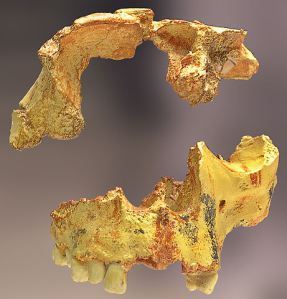
Fossil of Homo antecessor
The creatures are considered human, but they were not “us”. Whether their species is an ancestor of modern humans or not is unclear. But I can relate to a small family, mucking around on an ancient beach, digging for Paleolithic clams. So much safer than spearing a buffalo.








February 19, 2014
Epic Journey – a poem by Kate Rauner
A tiny little bat,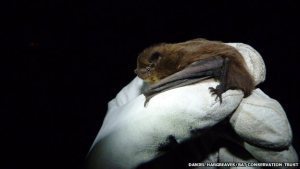
That can sit upon your thumb,
Has made a risky journey
That none have ever done.
At least, none we have ever tracked
Across the wild North Sea,
From Bristol in the UK
Past Holland’s Zuiderzee.
Found in a barn, alas, deceased;
This traveler verifies
Just how far migrant bat
Individuals can fly.
What inspires such journeys?
Their epics they can’t tell.
Let’s offer up some poetry
For the tiny pipistrelle.
Thanks to http://www.bbc.co.uk/nature/25759149








February 15, 2014
Will We Find Extraterrestrial Life by 2040?
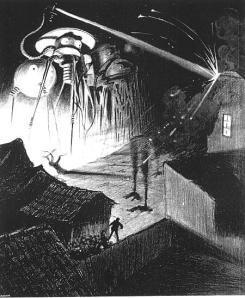
From the novel “War of the Worlds”
At space.com, a reader-survey shows 89% believe alien life exists elsewhere in the universe. Seth Shostak of the SETI (Search for Extraterrestrial Intelligence) Institute thinks there’s a good chance we’ll find evidence of that in the next 25 years. SETI Researchers have only listened for artificial signals from a few thousand star systems so far, but in 25 years they will have listened to a million systems. “A million might be the right number to find something.” Recent evidence of exoplanets helps fuel his optimism. In addition to SETI’s listening programs, the search for life includes rovers on Mars and the possibility that space telescopes could detect oxygen or other signs of life in exoplanet atmospheres.
Ever since Frank Drake set up his famous speculative equation, the search for extraterrestrial life has been a quixotic project, always on the brink of going broke. The search seems like such a long shot, yet it’s been too intriguing to abandon.
Would a confirmed, artificial signal – intelligence! – change anything? Polls show many people already believe intelligent aliens have visited Earth; for example, a poll in 2012 found only 17% of Americans think aliens have definitely not visited Earth, and one in ten say they’ve seen a “UFO” (assumed to be of extraterrestrial origin). People were even willing to speculate on which candidate in the last US Presidential election would handle an alien invasion better. Maybe most people would greet news of an intelligent signal from far out in space with a shrug. But it would send chills down my spine.








February 12, 2014
Northwest Passage – a poem by Kate Rauner
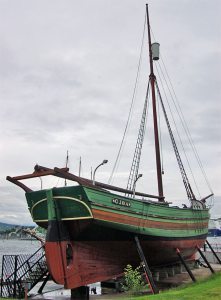
Now in an Oslo museum, the Gjoea took three years to sail the Northwest Passage in the early 1900s
Iced in America’s northern shore,
Frozen Northwest Passage.
Men have died, starving, freezing,
Seeking the Northwest Passage;
From Vikings to Victorians,
They sought the Northwest Passage.
Till the first commercial ship sailed through
There was no Northwest Passage.
In September twenty-thirteen,
Danes sailed the Northwest Passage.
In just one month a load of coal
Shipped through the Northwest Passage.
The frozen grip is loosened now;
Who made the Northwest Passage?
Each mile you drive, the power you use,
Creates the Northwest Passage.
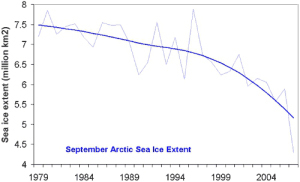
Extent of September Arctic ice, from http://www.SkepticalScience.com, a great site to learn about global warming and related climate change
February 8, 2014
Theoretically

Newton’s own copy of Principia with his hand-written corrections
Talking to people can be hard work. I have learned that I shouldn’t use jargon or buzz-words the other person does not understand in the same way I do. But there is a word in science that is hard to avoid using: theory.
In every-day speech, a theory is an idea or a notion; something speculative or something that should happen but may not. It is roughly what scientists call a hypothesis. In science, a theory is “an explanation or model based on observation, experimentation, and reasoning, especially one that has been tested and confirmed as a general principle helping to explain and predict natural phenomena.”
A scientific theory is closer to what we, in our every-day speech, call a fact. Here’s a word that means about the same thing in science. As Stephen Jay Gould says, “In science, ‘fact’ can only mean ‘confirmed to such a degree that it would be perverse to withhold provisional assent.’”
I can’t substitute the word “law”. In science, a law is a description without explanation, usually written as a mathematical equation: Newton’s Law of Universal Gravitation states F=Gm1m2/d2 . Besides, the word “law” already has an everyday meaning as a legal requirement.
There seems to be no simple popular word that means what “theory” means to science. I think most writers of popular science resort to defining “theory” for their readers. But when I hear a well-established scientific explanation dismissed by someone as “only a theory”, I know that tactic doesn’t work very well.
Does anyone have a good word or short phrase to suggest?








February 6, 2014
Zodiacal Light – a poem by Kate Rauner
Right after sunset, for an hour or two,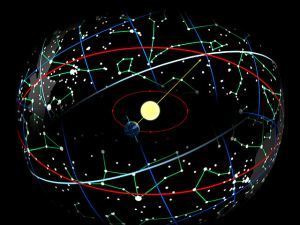
If the sky is quite clear and the ground lights are few,
If not masked by moonlight, you’ll see a faint glow;
The zodiacal cloud’s reflection will show.
Will spread ‘cross the sky frosting Archer and Bull,
Dusting Balance and Goat and Pitcher too full.
Traced by the planets, the ecliptic plane
Is powdered by comets with cosmic dust grains.
Triangular glow, apex pointing high
To the two Fishes whose tails are tied.
The heaviest specs come spiraling in,
Light the Ram and the Maiden, though wispy and dim.
The smallest escape, as solar winds blow,
Illuminate Ram and Crab as they go.
Before Islam’s false dawn or as twilight fades,
The Scorpion, Lion, in palest blaze.
Learn more about the zodiacal light and see some neat pictures at
http://en.wikipedia.org/wiki/Zodiacal_light








February 1, 2014
Orbital Science Ship Arrives
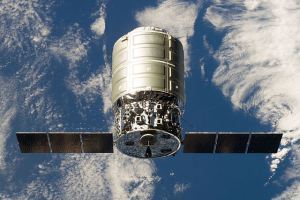
Cygnus
Orbital Science’s cargo spacecraft, Cygnus, arrived safely at the International Space Station with 2,780 pounds of supplies and scientific instruments. http://bit.ly/1dHN8Ct SpaceX and its Dragon spacecraft are also contracted for resupply missions as part of NASA’s Commercial Orbital Transportation Services project. Some of you may remember when NASA’s Shuttle was advertised as a “space truck” and the beginning of an era when space flight would be as common as airplanes are today. Maybe today’s commercial space companies will deliver on that promise.
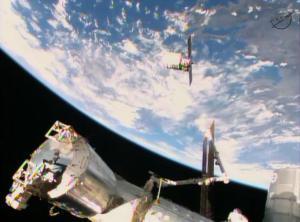
Arrives at ISS
What will future companies find profitable in space? Communications satellites are so common we only notice them when a problem pops up. Google Earth and GPS are part of every-day life. When we add stations on the moon or Mars, will they be government projects or private? Will metals mined from asteroids ever compete with mines here on Earth, or will zero-g manufacturing become indespensible? It’s all hard to envision today, but maybe that’s what people said about the airplane.



































